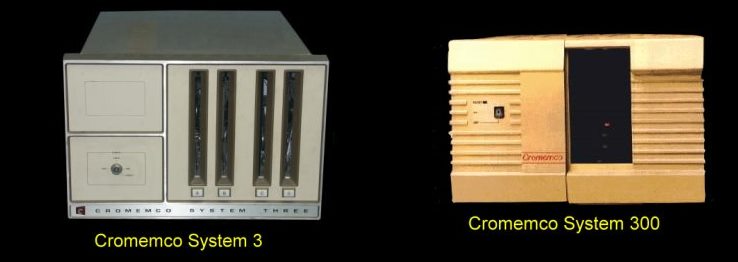Cromemco was arguably the most
successful of the S-100 companies. Their products were rock solid, pricey but
very popular in certain business segments. They had the widest range of boards,
systems and software of any company.
The
company was started in 1975 by two Stanford University grad students, Roger
Melen and Harry Garland who obtained a very early Altair S-100 computer (serial
number 0002 apparently) that year. They were quite impressed with the concept of
a homebrew computer and decided to to setup a company themselves. They
talked with
Ed Roberts/MITS
and initially discussed building a kind of video camera interface board for his
system called the "Cyclops". At the
time they lived in the CROthers MEMorial Hall dormitory on the Stanford campus -
thus the name
Cromemco. In 1976 they produced an S-100 board
called the
Dazzler for the S-100 bus.
It was the first color video board for the bus and it was a big hit. They soon
moved out of the dorm and formally setup the company in nearby Mountain View CA.
At their peak in the early 1980's they had over 500 employees. They tended to
specialize their business in unusual areas (both in equipment, software, and
business locations). Apparently at the time they were the largest suppliers of
micro-computers to China. Their computers were used widely by weather
forecasting groups -- somebody told me in some places they are still working and
the US military.
Like
TDL early on they saw the
advantages of the Z80 and from the get-go based their early products around that
chip. Their early S-100 systems were big computer frame mount boxes. You
could drop it 10 feet and it would probably still be working. As I said
above their boards were somewhat expansive and beyond the range of many
homebrewers at the time. Nevertheless the range of boards they made was
enormous. Later systems even evolved into non Intel CPU's systems. They
had their own Z80 Assembler (excellent BTW) Basic, Fortran and many other
language packages. They never did completely accept CPM but had their own "look
alike" system called CDOS and a multiuser system called CROMIX. Unlike others
they had an European branch that was quite successful in Germany.
In 1987 they were bought out by a
company called Dynatech who had used their systems for weather forecasting on
TV. The European entity survived longer and I hear has been recast in Zug
Switzerland.
Cromemco had a number of complete
systems over the years.



